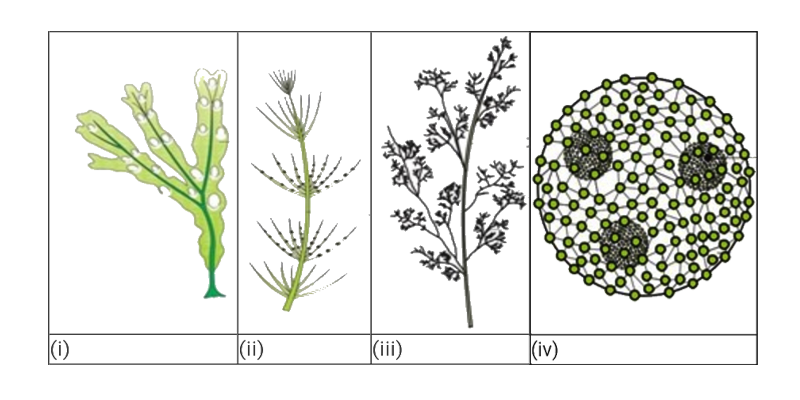Haplo-diplontic life cycle is found in
bryophytes
pteridophytes
fungi
both a and b
The correct Answer is:D
Step-by-Step Solution:
1. Understanding the Term "Haplo-Diplontic Life Cycle":
- The haplo-diplontic life cycle refers to a life cycle that includes both haploid (n) and diploid (2n) stages. In this cycle, there is a clear alternation of generations between the haploid gametophyte and the diploid sporophyte.
2. Identifying the Phases:
- The life cycle is divided into two main phases:
- Haploid Phase (Gametophyte): This phase produces gametes (sperm and eggs) and is characterized by having a single set of chromosomes (haploid).
- Diploid Phase (Sporophyte): This phase produces spores and is characterized by having two sets of chromosomes (diploid).
3. Examples of Organisms with Haplo-Diplontic Life Cycle:
- The question asks which groups of organisms exhibit this type of life cycle.
- Bryophytes: These include mosses, liverworts, and hornworts. They have a dominant gametophyte stage and a shorter sporophyte stage.
- Pteridophytes: These include ferns and horsetails. They also exhibit a dominant sporophyte stage but have a significant gametophyte stage as well.
4. Conclusion:
- Both bryophytes and pteridophytes exhibit the haplo-diplontic life cycle. Therefore, the correct answer to the question is both A and B (which refers to both bryophytes and pteridophytes).
Final Answer:
The haplo-diplontic life cycle is found in both A and B (bryophytes and pteridophytes).
---
- The haplo-diplontic life cycle refers to a life cycle that includes both haploid (n) and diploid (2n) stages. In this cycle, there is a clear alternation of generations between the haploid gametophyte and the diploid sporophyte.
- The life cycle is divided into two main phases:
- Haploid Phase (Gametophyte): This phase produces gametes (sperm and eggs) and is characterized by having a single set of chromosomes (haploid).
- Diploid Phase (Sporophyte): This phase produces spores and is characterized by having two sets of chromosomes (diploid).
- The question asks which groups of organisms exhibit this type of life cycle.
- Bryophytes: These include mosses, liverworts, and hornworts. They have a dominant gametophyte stage and a shorter sporophyte stage.
- Pteridophytes: These include ferns and horsetails. They also exhibit a dominant sporophyte stage but have a significant gametophyte stage as well.
- Both bryophytes and pteridophytes exhibit the haplo-diplontic life cycle. Therefore, the correct answer to the question is both A and B (which refers to both bryophytes and pteridophytes).
The haplo-diplontic life cycle is found in both A and B (bryophytes and pteridophytes).
Topper's Solved these Questions
- PLANT KINGDOMBook:NCERT FINGERTPS ENGLISHChapter:PLANT KINGDOMExercise:Assertion Reason
Explore 15 Videos
- PLANT KINGDOMBook:NCERT FINGERTPS ENGLISHChapter:PLANT KINGDOMExercise:Plant Kingdom
Explore 160 Videos
- PLANT GROWTH AND DEVELOPMENTBook:NCERT FINGERTPS ENGLISHChapter:PLANT GROWTH AND DEVELOPMENTExercise:Plant Growth And Development
Explore 154 Videos
- RESPIRATION IN PLANTSBook:NCERT FINGERTPS ENGLISHChapter:RESPIRATION IN PLANTSExercise:Respiration In Plants
Explore 130 Videos
Similar Questions
Haplodiplontic life cycle is observed in
View SolutionWith the help of a schematic diagram describe the haplo-diplontic life cycle pattern in plants.
View SolutionWhich of these algae have a haplo - diplontic life cycle ?

View SolutionHaplontic life cycle is absent in :
View SolutionWhich of these algae exhibit the haplo-diplontic life cycle?
View SolutionStatement I : Diplo-haplontic or haplo-diplontic life cycle is characterized by the existence of a sporophyte ae wall as a gametophyte.
Statement II : Fungi have a haplo-diplontic life cycle .
View SolutionDraw labelled diagram of haplontic , diplontic and haplo-diplonatic life cycle of plants, with examples.
View SolutionLife cycle is haplontic in
View SolutionWhich of the following pairs of organisms are correctly matched with their description ?
1. Pteridophytes which are heterosporous : Selaginella , salvinia
2. Gymnosperms with branched stem : Pinus , Cedrus
3. Algae with haplo - diplontic life cycle : Ectocarpus, polysiphonia
4. Bryophytes with protonema stage : polytrichum , sphagnum
View SolutionLife cycle in ferns is
View Solution

